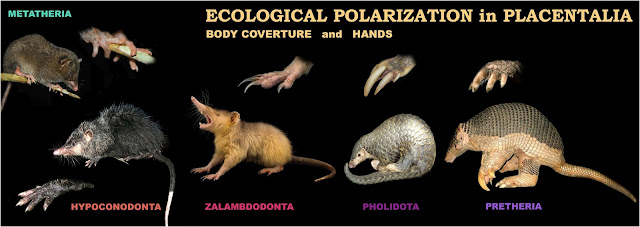The changes occurred in EOCENE Period (The Growth of Planet EARTH), caused alterations in the global climate. The level of atmospheric moisture declined gradually from that period. Drier areas appeared between the forested areas earlier continuous. In this scenario the evolution gained a higher rate. Life has changed.
Probably the TERRESTRIA-ARBOREA ancestor presented a polymorphism, that precede these ecological breaks. The evolution of phyllostomid bats suggests something like that. Being, as everything indicates, populations of humid forests, the evolutionary rate on these stocks, should be close to zero. Mutations were happening in a constant rate and probably ought to be a large accumulation of them. Ready to respond to the changing that were to come. The geographical distribution of characters is expressed through polarities. As I put it in previous posts, these polarities are produced by environmental limits, usually climatic. They will also depend upon the versatility of the organisms in question. In this case particularly, insectivorous or small carnivores, the ecological limits are very broad. Such conditions further reinforce the thesis of polymorphism, because we are dealing with animals that could be considered as generalists.
The illustration we see here is part of another post that can be seen on Flickr. But modified to serve a more specific analysis.
Pay attention ... when the great climatic and ecological changes began to happen ... some groups, specifically .... took the lead in this great endeavor. In the picture below, we have a point...a zone! A STRESS ZONE !
The question is ..... why these groups specifically ? At this point, enters the Cloud of Characters Theory !
We can divide the TERRESTRIA (gradistically) in 3 groups:
1) Zalambdodonta with conservative teeth similar to those of the marsupials and no doubt to the first Theria. Small animals with tiny eyes (or even absent), incomplete zygomatic arches, large nails and absence of a "caecum", similar to those points to Pholidota (with the exception of the teeth, of course). I put it in the "pole" next to them.
2) Erinaceoidea a central group (gradistically). They do not have a "caecum" as Zalambdodonta, but have a dentition clearly derived, as Caecoidea. The feet are not provided with long nails (only in the derivatives like moles) and they are small animals, even a group marked by "paedomorphosis".
3) Caecoidea the most derivative, with a large developed "caecum", dentition derived, with specialized incisors (except aardvarks), ever-growing teeth (particularly the I1), and including large bodied animals.
We have before our eyes a clear polarity, with beginning, middle and end.
1) Archonta, an extremely arboreal GROUP, even more derived (from its base) than the most basal of the Marsupialia. They formed a side branch in the great line of the distribution of characters.
They set a polarity mainly with the Carnivora, but also with marsupials and to a lesser extent with other basal Ferungulata.
2) Carnivora, located at the "marsupial pole" of the Eutheria, but presenting a reduction of incisors and a development of the canines, even a property of the all Ferungulata. They have a "caecum", but not particularly well developed and were primitively, small animals.
3) The "Ungulata" formed by "Condylarthra" (at base), Artiodactyla and Perissodactyla, with "Condylarthra", no doubt, in the great line of characters, polarized with Carnivora at one end. This group is comparable, in degree of evolution, to the Caecoidea. Within this group we find large animals like whales, hippos, rhinos, the now extinct Paraceratherium (= Baluchitherium) and the buffaloes, to name a few. In this group we find the most specialized teeth and more developed "caecae" and digestive sistems, in addition to specializations in the paws and types of locomotion.
Returning to the question posed above, about the "stress zone". Here, I propose a pattern of "breaking" in populations, as a complementation to the "Theory of the Cloud of Characters". I identify a pattern, in which forms a kind of intermediate ancestor with a great variability, before a break (between two groups), due to the destabilization of the environment. Look at the picture in this LINK, a scheme that will help the transmission of this complex idea.
I developed these ideas (all) when I worked in my "Revision of the genus Monodelphis". This work has never stopped. I endeavor to deepen it, because everything was measured and calculated. I examined numerous specimens and compared a multitude of animals to get where I am.
Two very interesting points caught my attention: 1) The dispersion of the species (which I called the eastern groups) and 2) the changes occurring in populations of Monodelphis americana in Central Brasil.
Por que "esses grupos especificamente" tomaram a frente na evolução e se diferenciaram desta forma. Estavam "preparados" por algum motivo ?
Usarei o português para tratar dessa ideia complexa...
"Se uma população contínua sofre uma "pressão" ambiental localizada, a seleção deslocará as Normas numa certa direção. Com a seleção daqueles indivíduos, que podem sobreviver ali. Com o avanço dessa transformação pode ocorrer duas coisas:
1) Adaptação e estabilização, ou 2) Ruptura com extinção localizada. Mas certamente se formarão pólos de resistência, que permanecerão em contato com as populações laterais. Uma explicação para algo que existe de fato, que está manifestado na distribuição dos caracteres de muitos grupos. Isso é TEORIA.


Nenhum comentário:
Postar um comentário
Observação: somente um membro deste blog pode postar um comentário.